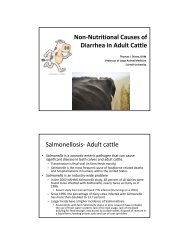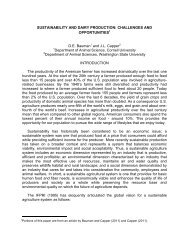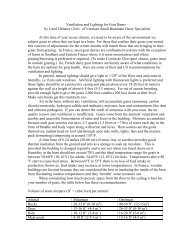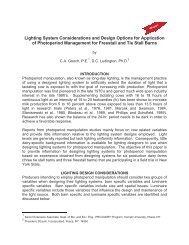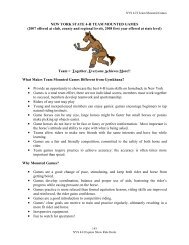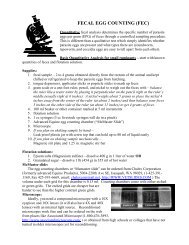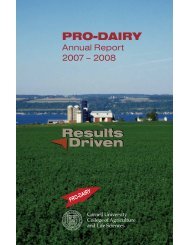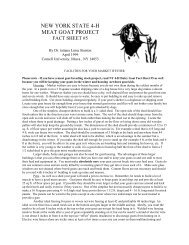Reduce the risk of stray voltage
Reduce the risk of stray voltage
Reduce the risk of stray voltage
Create successful ePaper yourself
Turn your PDF publications into a flip-book with our unique Google optimized e-Paper software.
THE MANAGERDa i ry FacilitiesBy Richard PetersonWhen <strong>stray</strong><strong>voltage</strong> occurs,it can wreckhavoc on adairy. Avoid itat all cost.<strong>Reduce</strong> <strong>the</strong> <strong>risk</strong> <strong>of</strong> <strong>stray</strong><strong>voltage</strong>Stray <strong>voltage</strong> isn’t what <strong>the</strong> name implies. It’s nota <strong>voltage</strong> that has spilled out <strong>of</strong> <strong>the</strong> wires,and wandered<strong>of</strong>f. Stray <strong>voltage</strong> is a natural electrical phenomenonassociated with <strong>the</strong> normal functioning <strong>of</strong>an electrical system. It follows <strong>the</strong> laws <strong>of</strong> physics,notably Ohm’s Law.The secondary (farm) electrical system andgrounded primary (utility) electrical systems bothhave a neutral conductor grounded to <strong>the</strong> earth. Inall electrical systems, current flows from <strong>the</strong> source,through <strong>the</strong> electrical load and back to <strong>the</strong> source tocomplete <strong>the</strong> circuit. The source on <strong>the</strong> utility systemis <strong>the</strong> substation; on a farm it’s <strong>the</strong> transformer.Though most <strong>of</strong> <strong>the</strong> current flows back to <strong>the</strong>source through <strong>the</strong> neutral wire, some may flowthrough <strong>the</strong> earth. This current can cause a small<strong>voltage</strong> that can be measured on metal objects, suchas waterers, and <strong>the</strong> adjacent floor or earth. This isknown as neutral-to-earth <strong>voltage</strong> (NEV).If <strong>the</strong>re’s a <strong>voltage</strong>, current (amperes) can flowbetween <strong>the</strong> two points if <strong>the</strong>y’re contacted simultaneously.In a dairy facility, current may flow througha cow when she comes in contact with metal equipmentthat has a different electrical potential than <strong>the</strong>concrete floor she’s standing on. This is called <strong>stray</strong>,or cow contact, <strong>voltage</strong>.Dairy cows have much lower resistance to electricalcurrent flow than humans. Human resistanceranges from about 500 to 5000 ohms for broken skinto as high as 10,000 to 300,000 ohms for dry skin.Dairy cows’ range <strong>of</strong> resistance is 300 to 1200 ohms.In wet areas, a cow’s resistance is about 500 ohms.Studies conducted at several universities suggestit takes at least 4 milliamp (mA) to cause behavioralchanges in cattle. Using Ohm’s law, E (<strong>voltage</strong>) =I (current) x R (resistance), a 4 mA current flowthrough a 500-ohm resistance equates to about 2volts. Generally, <strong>voltage</strong>s between <strong>the</strong> earth or concretefloor and metal cow-contact surfaces should be1 volt or less.This low <strong>voltage</strong> and current won’t directly harma cow, but exposure can cause avoidance behavior.A cow exposed to this current in <strong>the</strong> milking parlormay try to avoid entering <strong>the</strong> parlor or not let milkdown properly. If she’s exposed to <strong>the</strong> current from ametal waterer, she may avoid drinking.Figure 1. How cowsare exposed to <strong>stray</strong><strong>voltage</strong>Secondary neutralBarn entrance panelBondGroundwireGround rodGroundedwatererCURRENT PATHCommon sources <strong>of</strong> <strong>stray</strong> <strong>voltage</strong>On-farm sources include:1. Secondary neutral-to-earth <strong>voltage</strong> caused by ahigh resistance neutral or unbalanced 120-volt loads.This is one <strong>of</strong> <strong>the</strong> most common causes <strong>of</strong> <strong>stray</strong> <strong>voltage</strong>.FYI■ Dick Peterson is president <strong>of</strong> Nor<strong>the</strong>ast AgriculturalTechnology Corp. in Ithaca, N.Y. NATC is an agriculturalenergy applications consulting firm. It also conducts on-farm<strong>stray</strong> <strong>voltage</strong> investigations. Reach him at 607-725-2741.Email: clkp329@aol.com■ Find information about <strong>the</strong> installation <strong>of</strong> equipotentialplanes in <strong>the</strong> American Society <strong>of</strong> Agricultural andBiological Engineers (ASABE) Standards book in <strong>the</strong> sectiontitled Engineering Practice (EP473.2 Jan 01), EquipotentialPlane in Animal Confinement Areas. Website: www.asabe.org. Tel: 269-429-0300. Email: hg@asabe.orgApril 2008 PRO-DAIRY • Nor<strong>the</strong>ast DairyBusiness 39
Figure 2. Equipotential plane in a milking parlor and holding areaTHE MANAGERVoltage rampsEquipotential plane2. Improper wiring.3. Ground faults caused by loose wire connections, damagedwire insulation or wet electrical terminals.Off-farm sources include ground faults at a neighboring location,telephone or cable television grounding systems and NEVon <strong>the</strong> primary electrical system, which can impose a NEV on<strong>the</strong> secondary wiring system on a farm.Nix <strong>stray</strong> <strong>voltage</strong>When planning new dairy facilities, you can do several thingsto reduce <strong>stray</strong> <strong>voltage</strong> occurrences. Meeting <strong>the</strong>se requirementsin existing facilities will also reduce <strong>the</strong> possibility <strong>of</strong> <strong>stray</strong> <strong>voltage</strong>.1. First, ensure all wiring meets <strong>the</strong> National Electric Code®(NEC) requirements. Improper wiring can create a variety <strong>of</strong>electrical conditions that can lead to higher levels <strong>of</strong> NEV <strong>voltage</strong>,increasing <strong>the</strong> <strong>risk</strong> <strong>of</strong> exposure to <strong>stray</strong> <strong>voltage</strong> at cow-contactpoints. Some wiring considerations:■ Properly size electric service, considering future loads.■ If your dairy has a 120/240-volt electrical system, have yourelectrician carefully balance all 120-volt loads. Unbalanced 120-voltloads can cause a high level <strong>of</strong> NEV on <strong>the</strong> neutral, thus increasing<strong>the</strong> <strong>risk</strong> <strong>of</strong> <strong>stray</strong> <strong>voltage</strong> exposure. Whenever possible, use 240-voltra<strong>the</strong>r than 120-volt motors to help reduce unbalanced loads.■ Provide for proper service and equipment grounding.■ Size electric wires based on circuit lengths and electric loads.■ Plan and install equipotential planes in all concrete floors in alllivestock confinement areas where metal equipment could becomeenergized and cattle can make contact. The equipotential plane puts<strong>the</strong> concrete floor at <strong>the</strong> same electrical potential as <strong>the</strong> adjacent equipment.When a cow comes in contact with <strong>the</strong> metal equipment, <strong>the</strong>re’sno potential difference, and current won’t flow through <strong>the</strong> cow.An equipotential plane, required in all new construction, is createdby electrically bonding <strong>the</strong> reinforcing mesh in <strong>the</strong> concretefloors to <strong>the</strong> farm’s grounding system. It’s important to establish atransition where cows enter or exit <strong>the</strong> building. (Figure 2.)■ Properly ground all electric fencer systems. Keep fencergrounds separate from grounding on <strong>the</strong> farm electric system.2. Have a qualified electrician inspect <strong>the</strong> farm electrical systemannually. Routinely include a check for <strong>stray</strong> <strong>voltage</strong>.3. Maintain your electrical system, including frequent inspection<strong>of</strong> wires, to evaluate its condition. Immediately repair damagedwires or panels, and check and tighten terminal connections andsplices. Damaged wiring can lead to faults that produce abnormallyhigh NEV levels.Loose or high resistance neutral connections can cause morereturn current to flow through <strong>the</strong> earth, thus increasing NEV levels.4. Consider wiring all subpanels with four wires to allow separation<strong>of</strong> <strong>the</strong> system neutral and equipment grounding conductors.On most farms using a single phase 120/240-volt power system,subpanels are usually served from <strong>the</strong> main service panel by athree-wire system. It consists <strong>of</strong> two ungrounded conductors and agrounded neutral conductor.Though NEC allows <strong>the</strong>se systems, <strong>the</strong>y have a drawback. TheirMILKING PITReturnalleyHOLDING AREA6 x 6 no. 10 guage welded-wire mesh in holding area,milking parlor and milking pit floors.Source: “Equipotential Planes for Stray Voltage Reduction,” published by <strong>the</strong> MidwestRural Energy Council.electrical equipment grounds are tied to <strong>the</strong> neutral conductor. Afault in an electric motor causes a high fault current to flow onto <strong>the</strong>neutral and produce a serious NEV condition.The four-wire system to serve subpanels avoids this.This systemhas two hot wires, a grounded neutral conductor and a separateequipment grounding wire. An electrical fault in a motor will causecurrent to flow through <strong>the</strong> grounding conductor directly to <strong>the</strong> serviceground. NEV levels on <strong>the</strong> neutral conductor won’t increase,and cows won’t be exposed to <strong>stray</strong> <strong>voltage</strong> when <strong>the</strong>y touch metalequipment tied to <strong>the</strong> neutral system.5. If a dairy is supplied by a grounded neutral (wye) primary and<strong>the</strong>re are elevated NEV on <strong>the</strong> primary system, consult with yourutility about isolating <strong>the</strong> primary and secondary neutral systems.Request a <strong>stray</strong> <strong>voltage</strong> check. If high NEV levels are found on <strong>the</strong>primary electrical system, <strong>the</strong> utility will take corrective action. Anyproblems on <strong>the</strong> dairy’s electrical system must also be corrected.If <strong>the</strong> utility finds a significant <strong>voltage</strong> on <strong>the</strong> neutral that causescow contact <strong>voltage</strong>s <strong>of</strong> 1 volt or more, it may install a neutral isolationdevice that separates <strong>the</strong> utility neutral from <strong>the</strong> farm neutralsystem. This will prevent current flowing from one onto <strong>the</strong> o<strong>the</strong>r.After <strong>the</strong> utility isolates <strong>the</strong> neutral system, notify telephoneand cable companies so <strong>the</strong>y can install isolation devices on <strong>the</strong>irgrounding systems. O<strong>the</strong>rwise, <strong>the</strong>ir systems can bypass <strong>the</strong> neutralisolation system, and <strong>the</strong> dairy will still experience elevated NEV.In rural areas many utilities still operate delta systems whichhave no neutral conductor. Current flows from <strong>the</strong> source on onehot conductor and back to <strong>the</strong> source on ano<strong>the</strong>r hot conductor.Since a delta primary system doesn’t have a neutral, no NEV canbe imposed onto <strong>the</strong> secondary neutral system from <strong>the</strong> utility. ButNEV could still occur, probably related to wiring problems.Rarely, a neighboring farm, business or residence could have afault in electrical equipment such as a submersible pump. Currentcould flow from <strong>the</strong> faulted equipment through <strong>the</strong> earth to yourdairy and into metal equipment that cows contact. This is rare, fortunately,because it’s also <strong>of</strong>ten difficult to resolve.If you suspect <strong>stray</strong> <strong>voltage</strong> is impacting your cows, hire a qualifiedelectrician to inspect your electrical system. Have an experiencedperson take <strong>voltage</strong> measurements at cow contact areas. If1 volt or more is measured and <strong>the</strong> problem can’t be traced to anon-farm cause, request your utility conduct a test. With communicationsand cooperation, most <strong>stray</strong> <strong>voltage</strong> incidences can be resolvedquickly. xz40 Nor<strong>the</strong>ast DairyBusiness • PRO-DAIRY April 2008



